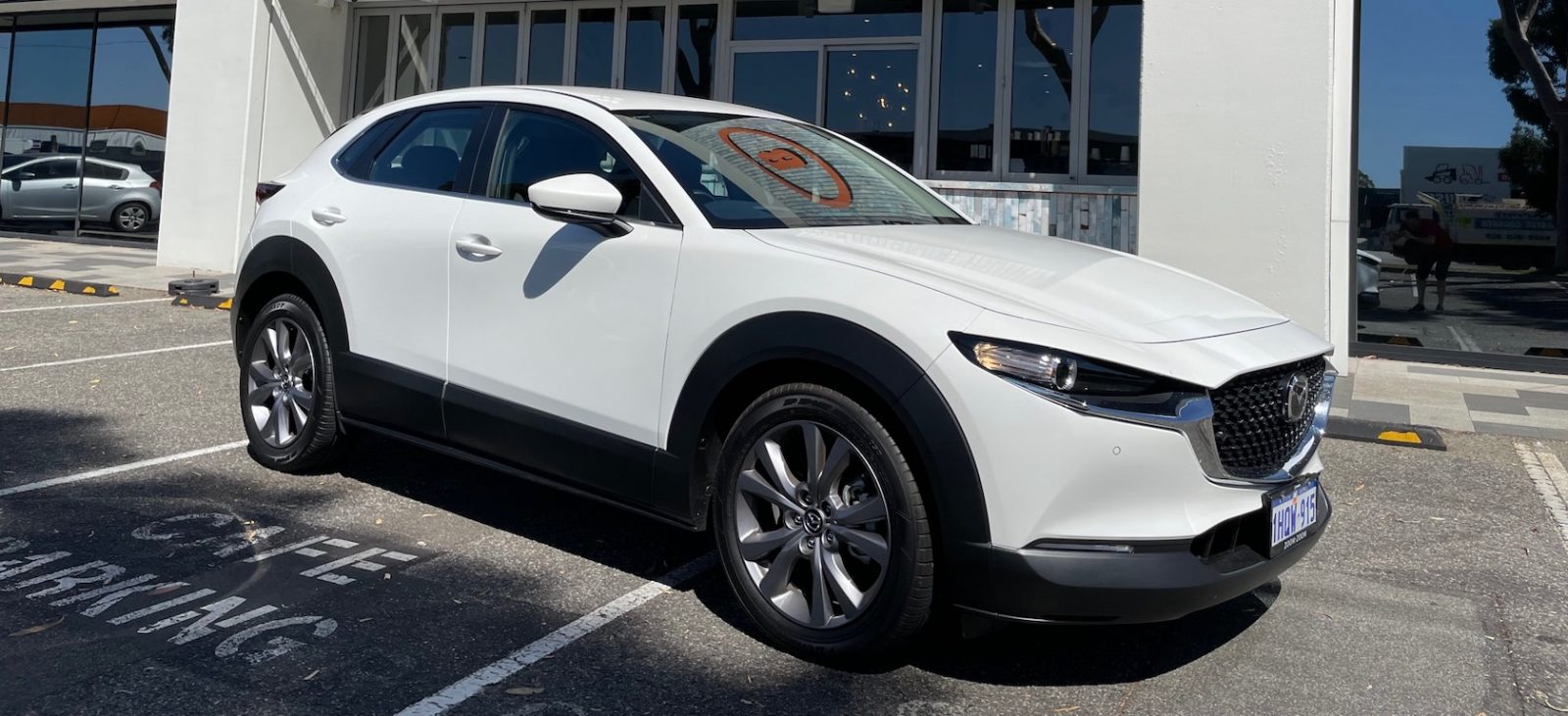- Boasts the best styling in the genre
- With the mild hybrid, the CX-30 generates enough grunt
- Interior design and material quality are top notch
- The Mazda powertrain is adequate but could do with a little more power
- The central tunnel restricts rear legroom
- Mild hybrid versions are not yet available in the U.S.
Based on the Mazda 3 hatch, the CX-30 is a good-looking car, arguably the best in its segment. And that segment just happens to be one of the most competitive genres in the industry populated by established segment heavyweights including the Audi Q3, BMW X2, Mercedes GLA, Volvo XC40, Toyota C-HR, and Range Rover Evoque.
Mazda CX-30 slots in between CX-3 and CX-5
So to be competitive, you must have a few special traits to win over customers. The CX-30 has those. Apart from its stylish looks, the little Mazda has a premium quality interior, sporty ride and handling, good mileage, and practicality. It’s not perfect though, as it loses out to most rivals in the performance category, mainly due to its Skyactiv powertrains which lean heavily towards frugality and away from power. In Europe at least, this is the car that could become the firm’s best-seller, while it makes a mark in North America.
But why is it called CX-30 given that it slots in between the CX-3 and CX-5? Seems straightforward that it’d be called the CX-4, right? It just so happens that the CX-4 already exists as a model in the Chinese market and is a sleeker SUV with a lower roof.
In terms of size though, the CX-30 is basically a Mazda 3 on platform shoes. It employs the 3’s platform but rides higher, has a little more interior room, and has slightly taller bodywork but with a more practical rear third and rugged-looking black cladding surrounding the sills and wheel arches. So under the skin, it uses the 3’s chassis while also incorporating the same engines—namely a 114-hp 1.8-liter Skyactiv-D diesel and a 120-hp SkyActiv-G 2.0-liter gasoline mild hybrid, as driven here with a six-speed automatic gearbox. We chose the gasoline version this time, as diesel in Australia, where we tested it, was crazy expensive.
What more can we say about the exterior design of Mazda’s SUVs that has not already been said? They are all beautifully styled with gorgeous proportions. Mazda builds the best-looking vehicles in Japan, by far, and vies with the like of Audi, Kia, and one or two others for the world’s best-looking hatches and SUVs.
CX-30’s interior design and quality is some of the best in the industry
Inside, the dashboard layout and switchgear are similar to that of the Mazda 3, with the CX-30’s level of perceived quality equal to that of the 3. Materials are well thought out and high-quality, switches work efficiently and are sensibly positioned on and around the dash, and the newly designed 8.8-inch infotainment screen sits on top of the center console. It boasts top-notch graphics but is not a touchscreen, meaning you have to use the controls on the center console. Its reverse camera offers high-definition images to cover those blind spots when reversing. It’s an understatement to say that the CX-30 takes it right up to premium rivals for levels of luxury, and leaves behind its more mainstream rivals.
Although the front two seats offer loads of room and an excellent driving position and visibility, taller passengers will find the rear seats restrictive in terms of leg and headroom while the unusually tall transmission tunnel limits legroom for the middle-seat passenger. A nice touch is the high-quality 12-speaker Bose sound system, available on the top-spec models.
Now we get to one of the highlights of the CX-30. Our test car was powered by the 2.0-liter, 4-cylinder, Skyactiv-G gasoline engine that’s mated to a 24-volt mild hybrid system. This system uses regenerative braking to channel energy back to the onboard lithium-ion batteries which helps to lower fuel consumption while adding bottom-end torque to the car’s performance.
2.0-liter gasoline engine and 6-speed gearbox offer good smooth acceleration
With the mild hybrid the CX-30 actually generates some decent acceleration, reaching 60 mph in under 9 seconds. While not explosive the little Mazda SUV gets off the mark quickly enough and can merge meaningfully onto highways at speed. It is rarely wanting for power, thanks to a nicely matched 6-speed automatic gearbox that helps to get the car up to speed as much on city streets as it does on hilly roads and highways.
Even with the elevated ride height, Mazda’s engineers have done well to minimize body roll driving enthusiasts will enjoy are the precise, well-weighted steering, which quells any hint of understeer, and the brakes which offer plenty of early bite and grip.
At cruising speed, the ride quality is excellent with minimal road and wind noise entering the cabin—making the CX-30 a pleasant car to drive. From a driver’s standpoint, the cabin design and material quality also add to the overall driving experience, which is one feature that can easily sway drivers towards a product.
CONCLUSION
If you’re in the hunt for a good-looking compact SUV that drives well and won’t break the bank then the CX-30 might be for you. However, if you’re searching for a sportier SUV with more grunt then perhaps you might lean toward the German trio. Unfortunately, the 2.0-liter mild hybrid model we drove in Australia is not available in the U.S.—so in its place, we’d suggest the 191-hp 2.5-liter naturally aspirated gasoline version starting at $22,950.
